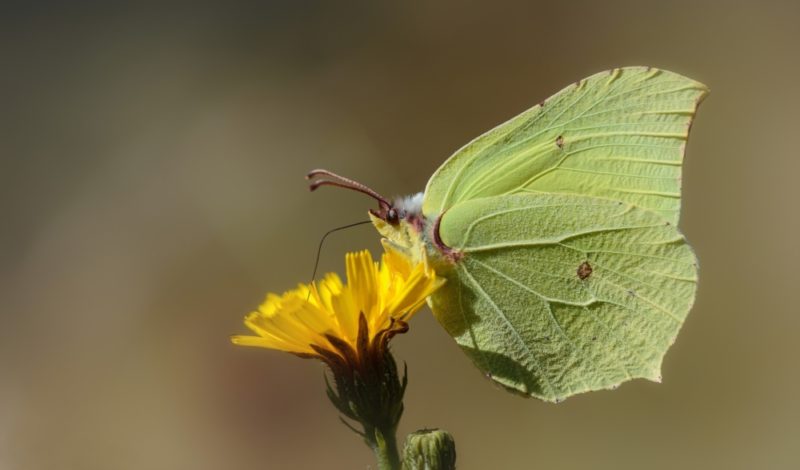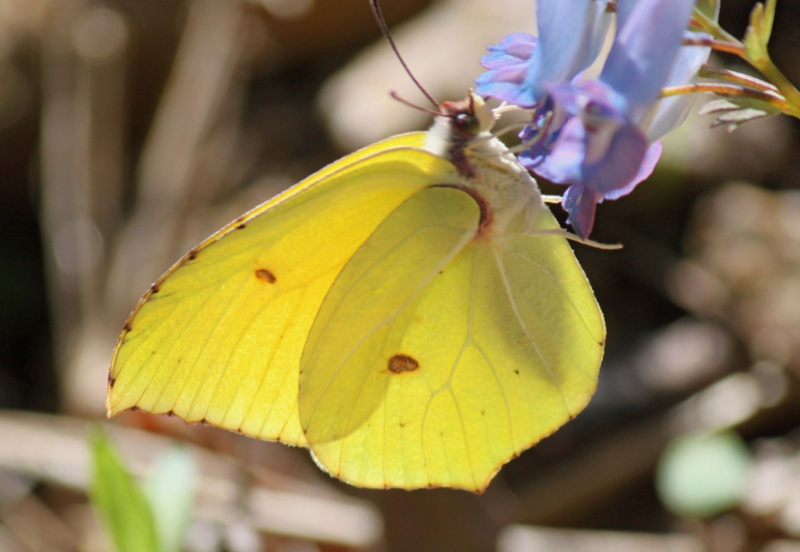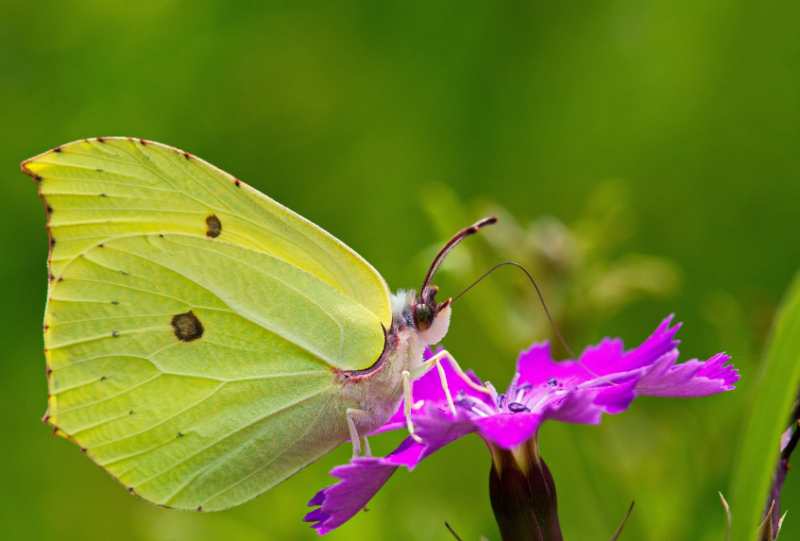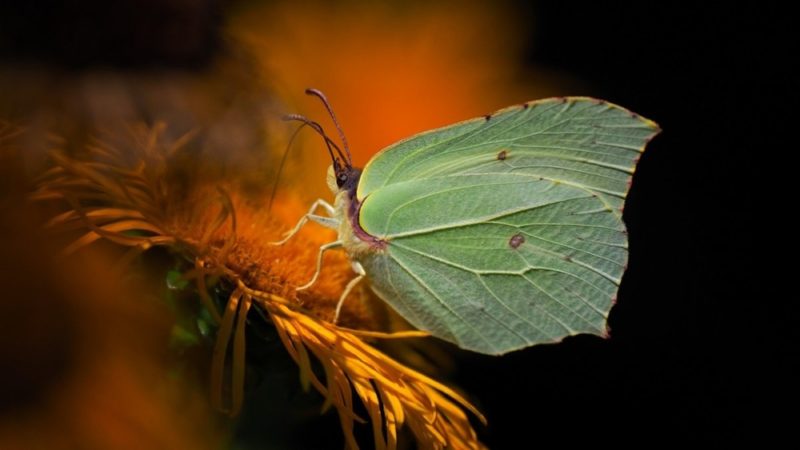The view fell into all kinds of books of records and collections of interesting facts about insects. The reason for this popularity is that the lemongrass butterfly survives at low temperatures and overwinter thanks to a special fluid in the body. Compared to other moths, it is a long-liver.
Material Content:
Description and features of lemongrass butterfly
Schisandra vulgaris is also called a butterfly buckthorn (lat.Gonepteryx rhamni). The second name appeared due to the addiction of the insect to food on buckthorn (Rhamnus).
Description of the genus lemongrass:
- The wingspan is from 5 to 5.5 cm.
- The dark chest and abdomen of the imago have a light pubescence of thin and short hairs.
- On all four wings of individuals of different sexes, there is one pointed tooth and an orange spot.
- Three pairs of slender legs hold the body of the insect on the shoots and flowers, allow you to safely move around the plants.
In the description of lemongrasses of the white family, they necessarily indicate that males have a more intense color than females. This phenomenon - sexual dimorphism - is found in many butterflies.
The head and body of the caterpillar have a masking matte green color. White longitudinal stripes, black dots and thin spikes are visible on the sides. The oral apparatus of the larva is a gnawing type.
Insect habitat
Yellow butterflies (male lemongrass) are among the first among daytime lepidoptera in March at a temperature of 15 ° C in places well warmed by the sun. This species is characterized by living not in open areas, in the fields, but closer to bushes.
Habitat Description:
- Buckthorn women prefer light deciduous and mixed forests.
- Found in glades warmed by the sun, edges, clearings.
- Often butterflies of this species are seen in gardens and parks.
- In the mountains, imagoes fly to a height of 2000 m above sea level.
Lemongrass is not rare or endangered due to its adaptive capabilities.
The range includes almost the entire territory of Europe, the Caucasus, Western and Southern Siberia (it does not live beyond the Arctic Circle). Buckthorn lives in Kazakhstan, Central and Asia Minor, North Africa.
Butterfly coloring
The wings of males are lemon or bright yellow. Non-specialists take a female with pale green wings for a cabbage - a representative of the genus of garden whites. Its caterpillar is a dangerous crucifer pest.
The underside of lemongrass wings has no bright eyes. Butterfly folds wings sitting on the bushes. In this form, the moth looks like a leaf of a plant. Masking coloring saves non-toxic insects from birds and other enemies.
Nutrition and lifestyle
The mouthpart of the butterfly is a sucking type in the form of a long proboscis. Adults collect nectar, prefer to eat on red thistle inflorescences, blue cornflower baskets, yellow dandelions do not bypass. Lemongrasses are one of the first pollinators in early spring.
In May - June, caterpillars live on various species of plants belonging to the Buckwheat family, mainly on fragile buckthorn. Larvae of the first age feed on the underside of the leaves, the next on the outer surface.
Adults fly on a sunny day, freeze for a while on branches. Butterflies expose wings to the sun for "warming up", as many cold-blooded animals do. In the evening, insects need a secluded place to rest. Usually they spend the night in thickets of bushes.
Lemongrasses are good flyers, migrate long distances in search of better habitats.
For a long and active life, butterflies need the accumulation, conservation and economical use of energy. Diapause helps to preserve the strength of lemongrasses. So called the periods during which the body is inactive, the metabolism slows down. The longest diapause in lemongrasses is winter. In summer, the duration of such rest does not exceed several weeks.
New-generation adults come in July, feed until the end of summer and fall, then hibernate. They do not seek shelter, but winter in leafy litter, dry plants. This is possible due to the fact that the butterfly produces its own “antifreeze”. During thaws at the end of winter, butterflies become active, but there are no flowers yet. Therefore, part of the imago does not overwinter.
Reproduction and longevity
In the spring, males are the first to leave after wintering. After the appearance of the females, the mating season begins. “Courting”, mating and fertilization occur in the crowns of trees and shrubs. The female lays eggs on the leaves, buds and branches of buckthorn.
- One female produces an average of 80 eggs. The masonry matures within 1 - 2 weeks.
- The young larva feeds and reaches a length of 15 to 17 mm.
- The full development of the caterpillar includes 5 phases (ages). On average, the period before pupation lasts 4 weeks. By the end of all phases of the development of the caterpillar grows to 35 mm.
- The butterfly leaves 2 weeks after pupation. The entire cycle from the egg to the appearance of the imago takes 50 days.
Lemongrass in the adult state winters, leaves in March - April. Butterflies are especially active from April to June. They feed, mate, and produce offspring. Already in August, a new generation of butterflies appeared to replace overwintered individuals. They remain the winter and begin to fly next spring.
Unlike many other Lepidoptera, the adult phase in the life of lemongrass takes up most of its life. An adult butterfly lives from 10 months to 1 year. During this period, only one generation appears in moths.
Interesting Facts
In the body of lemongrass, changes are occurring that allow you to survive the frosty winter.The body of the insect produces and accumulates glycerin - the main component of the natural "antifreeze" of the insect. In dry grass and leaves, the butterfly tolerates a temperature of –20 ° С.
Lemongrass is one of the most long-lived and hardy day butterflies.
Interesting facts from the life of buckthorn women are mainly related to their amazing ability to winter in adulthood. This is the longest-living day butterfly in the vastness of Eurasia.

















